« April 2013 | Main | June 2013 »
May 28, 2013
Rugged notebooks: challenges and opportunities
I've been working on setting up our new rugged notebook comparison tool over the past few days. So far, the tool, where users can compare the full specs of up to three rugged notebooks side-by-side and also quickly link to our analysis of the machines, has far fewer entries than our comparison tools for rugged handhelds and rugged tablets. As I asked myself why there were only relatively few products out there, I thought about the overall rugged notebook situation.
A little while ago I came across a news brief by DigiTimes, the Taipei-based tech news service that's always interesting to read (albeit not always totally accurate). The news item was about Getac gunning for an increased market share in rugged notebooks. Digitimes said the current worldwide rugged notebook marketshare situation was something like Panasonic having 60%, Getac and General Dynamics Itronix each about 12.5%. They didn't specify the remaining 15%, but it's obviously a number of smaller players.
That news came just a short while after General Dynamics officially pulled the plug on Itronix, so those 12.5% that used to be GD-Itronix rugged notebooks such as the GD6000, GD8000 and GD8200, are now gone and up for grabs. Who will step up to bat? Will Getac take over what GD-Itronix used to have? Or will Panasonic's Toughbooks get even more dominant? Or will perhaps someone else emerge?
There's no easy answer. And the market is a rather fragmented one. First, it's not totally clear what makes a notebook "rugged." In the business we generally differentiate between "rugged" and "semi-rugged," where the more expensive fully rugged devices carry better sealing and are built to handle more abuse than semi-rugged models that offers somewhat less protection, but usually cost and weigh less in return. But rugged and semi-rugged are not the only designations you see in the market. Some manufacturers also use terms such as "business-rugged," "vehicle-rugged," "durable," or even "enterprise-rugged." There's also "fully-rugged" and "ultra-rugged."
Of machines on the market, we'd consider products such as the Panasonic Toughbook CF31, Getac B300 or GD-Itronix GD8200 as rugged, and the Panasonic Toughbook 53, the Getac S400 and the GD-Itronix GD6000 as semi-rugged. But then there are also notebooks specifically made for enterprise and business that are better made than run-of-the-mill consumer notebooks, but somehow defy definition. Examples are the very light magnesium notebooks by Panasonic that cost a lot more than any regular laptop and can take much more abuse, but do not look tough and rugged.
Then there's yet another category of laptops that are almost exclusively used for business and vertical market applications, and that's the convertible notebooks. These had their origin when the industry was intrigued by tablets in the early 1990s and then again in the early 2000's, but wasn't quite sure if customers would accept them, so they made something that could be used both as a tablet and as a laptop. These usually cost more than notebooks, and were heavier than tablets, but somehow the concept is still around, and there are many models to choose from. Some are fully rugged, such as the Getac V100/V200 and the Panasonic Toughbook 19, others are semi-rugged like the Panasonic Toughbook C2, or business-rugged, such as Lenovo ThinkPad X230t or the HP EliteBook 2760p.
Yet another category is rugged notebooks that are based on large volume consumer notebooks. Examples are the semi-rugged Dell Latitude ATG and the fully rugged Dell Latitude XFR. With Dell having quick and easy access to all the latest technology, the ATG at least is almost always at, or close to, the state-of-the-art in processors and other technology.
And there further twists. While the likes of Panasonic and Getac make their own notebooks, a good number of others are made by a small handful of OEMs under exclusive or (more often) non-exclusive agreements with resellers that put their own brand names and model numbers on the devices. Taiwanese Twinhead, for example, had a longstanding relationship with the now defunct General Dynamics Itronix, with some models exclusive to Itronix and others marketed by various vendors through different channels. That can make for interesting situations. While Twinhead was and is an important OEM, they also sold their mostly semi-rugged lineup under their own name and the Durabook brand, and also through their US subsidiary GammaTech.
But there's more. A number of smaller players, or small parts of larger industries, provide highly specialized rugged notebooks that are often so unique as to only target very narrow markets. Some machines are built specifically to the requirements of military and other government contracts. Their names and brands are usually unknown to anyone outside of the small circle of targeted customers.
Why are there so few rugged and semi-rugged notebooks? One reason is that the market for them isn't all that large. They are popular in police cars and similar applications, and wherever notebooks simply must be much better built than fragile consumer models. Another reason is price. Even relatively high-volume semi-rugged laptops cost two to three times as much as a similarly configured consumer model. Rugged notebooks run three to five times as much, and specialized models may be ten times as much.
By and large, the rugged computing industry has been doing a good job educating their customers to consider total cost of ownership as opposed to looking only at the initial purchase price, but it's not always an easy sell. And with handy, inexpensive tablets flooding the market, it isn't getting any easier. Add to that the fact that makers of rugged notebooks always had a special millstone hanging around their necks, that of having to make sure that products stay compatible with existing docks, peripherals and software. That often prevents them from adapting to new trends and switching to newer technologies and form factors (like, for example, wider screens) as quickly as some customers demand. While it's certainly nice to see Intel coming out with a new generation of ever-better processors every year or two, it's not making it easier for rugged manufacturers to stay current in technology and features either.
As is, if Itronix really had a roughly 12.5% market share, that slice of the pie is now up for grabs and it should be interesting to see who ends up with it.
Posted by conradb212 at 3:24 AM
May 17, 2013
How Motorola Solutions made two mobile computers condensation- and freezer-proof
Good phone conversation today with the PR folks from Motorola Solutions. The occasion was the introduction of two interesting new products, the Omni XT15f industrial handheld, and the Psion VH10f vehicle-mount computer. The key here is the "f" in both of the names. It stands for "freezer" and that's what the two new devices are all about. Big deal?
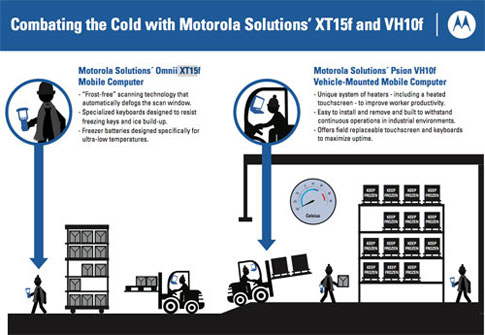
Actually, yes. At least for workers who use their computers in and around freezers. That includes storage of perishable foods, the strictly temperature-controlled environments where medications are stored, and numerous other places for goods that need to be or stay frozen. So what's the issue? You just get devices that can handle the cold and that's it, right?
Yes, and no. While the environmental specs of most rugged computing devices include their operating temperature range, the range only tells the temperatures within which the device can be used. In the real world, and particularly when working around freezers, temperature alone isn't the whole issue. What matters is how a device can handle frequent, rapid changes in temperature. The real enemy then becomes condensation, and not so much temperature. Extreme temperatures remain an issue, of course, but one that must be addressed as part of the larger issue of rapidly changing temperatures.
So what exactly happens? Well, if you go from a hot and humid loading dock into a freezer, the rapidly cooling air in and around a device loses its ability to carry moisture, which then becomes condensation. That condensation then freezes, which can cause frost on displays, rendering them illegible, frozen keys on the keypad, and possibly internal shorts. When the worker leaves the freezer environment, the frost quickly melts, again affecting legibility of the display and possibly causing electrical shorts. It's quite obvious that extended cycling between those two environments not only makes the device difficult to use, but it's almost certainly going to cause damage over time.
Now add to that the slowing down of displays in extreme cold and the general loss of battery capacity, and it becomes obvious why this is an issue for anyone using mobile computers in those environments. And hence the new "freezer" versions of those two Motorola Solutions products (Omnii XT15f on the left, Psion VH10f on the right).
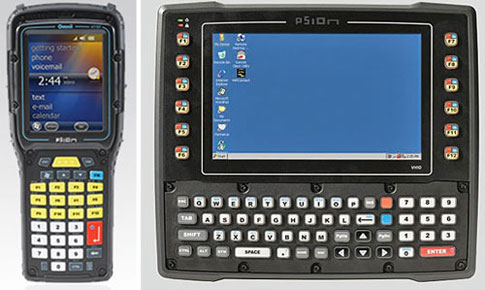
So what did Motorola do? Weber Shandwick's ever helpful Anne Norburg suggested I talk to the source and arranged the call, and so I had a chance to ask Amanda Honig, who is the Product and Solutions Marketing Manager for Enterprise Mobile Computing, and Bill Abelson of Motorola's media team. The overall challenge, they said, was to provide reliable "frost- and condensation-free" scanning. In order to do that, they had to address a number of issues:
Since the scan window can fog up, they used internal heaters to automatically defog the window, thus facilitating accurate scans under any condition.
Since external condensation can quickly freeze around keys and make the keypad difficult or impossible to operate, they designed special freeze-resistant keyboard layouts with larger and more widely spaces keys.
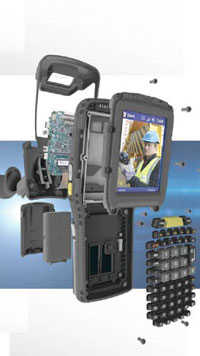 Since the airspace between the LCD display and the touchscreen overlay can fog up from condensation and make the display unreadable and imprecise to operate, they optically bonded layers to eliminate air spaces and used a heater to eliminate internal display fogging.
Since the airspace between the LCD display and the touchscreen overlay can fog up from condensation and make the display unreadable and imprecise to operate, they optically bonded layers to eliminate air spaces and used a heater to eliminate internal display fogging.
Since battery capacity tanks in very low temperatures and standard batteries can get damaged, they used special low temperature batteries with higher capacities and minimized performance loss at low temperatures.
And to make sure this all worked transparently and without needing any worker involvement, they included environmental sensors and heater logic circuitry so that the device automatically handles the rapidly changing temperatures and humidity. There are, however, also ways to do it manually.
Finally, since it makes no sense to overbuild, they offer two versions. One is called "Chiller" and is considered "condensation-resistant," with an operating temperature range of -4 to 122 degrees Fahrenheit. The other is called "Arctic" and is considered "condensation-free." That one can handle -22 to 122 degrees. The Chiller and Arctic versions add US$700 and US$1,100, respectively, to the cost of the basic Omni XT15 handheld computer. If it means fewer equipment hassles when getting in and out of freezers, that's a small price to pay.
There's another interesting aspect to all this. Changing and upgrading existing equipment is never easy, but in this case it was made easier because Psion, even prior to its acquisition by Motorola Solutions, had given much thought to modular design as a means to quickly and easily adapt to special requirements, easier maintenance, and also to future-proofing. At the very least this means much of the repairs and maintenance can be done in the field. And I wouldn't be surprised if it also made it easier to come up with these special versions
Posted by conradb212 at 11:19 PM
May 14, 2013
Handheld: Pursuit of a vision
I had a chance yesterday to meet over dinner with Sofia Löfblad, Marketing Director at Handheld Group AB, and Amy Urban who is the Director of Marketing at Handheld US. I hadn't seen them since I presented at the Handheld Business Partner Conference in Stockholm three years ago, and it was a pleasure catching up in person.
The Handheld Group (not to be confused with Hand Held Products, which is now part of Honeywell) is a remarkable rugged mobile computing success story. Having its origins as a distributor of vertical market mobile computers from the likes of Husky, TDS and others, Handheld went on to establish its own identity with its own distinct product lines. In fact, they call themselves a "virtual manufacturer."
What does that mean? Well, while it is not unusual for larger distributors to resell OEM products under their own name, Handheld went one step farther. They not only have their own brands (Nautiz for rugged handhelds, Algiz for rugged tablets), but also their own design language and color scheme (Sofia even knew the precise Pantone color numbers), and they often have exclusive arrangements with their OEMs. So in addition to having a very cohesive brand identity and consistent look, Handheld products are less likely to immediately be identified by industry followers as rebranded versions of a common design.
How has that worked out for the Handheld Group? Apparently quite well. They now have ten facilities all over the world, as well as several hundred authorized partners. And they've been able to score impressive wins like a contract for 10,000 rugged handhelds with Netherland Railways against much larger competition.
They also proved their knack for coming out with the right product at the right time with devices such as the Algiz 10X (a rugged but light and handy 10-inch tablet), the Algiz XRW (a super-compact rugged notebook), and the Nautiz X1, which they call the toughest smartphone in the world. On the surface, that doesn't sound all that terribly exciting, but it really is, and here's why:
I am on record as bemoaning the demise of the netbook, those small and handy notebooks that used to sell by the tens of millions. Then they disappeared due to a combination of being replaced by consumer tablets, and, even more so, an unfortunate industry tendency to keep netbooks so stunted in their capabilities as to render them virtually useless for anything but the most basic tasks. Well, now that they are gone, many wish they could still get a small, competent Windows notebook that's tough and rugged, but isn't as big, expensive and bulky as a full-size rugged notebook. And that is the Algiz XRW. I've liked it ever since I took an early version on a marine expedition to the Socorro islands a couple of years ago (see Case Study: Computers in Diving and Marine Exploration. And the latest is the best one yet (see here).
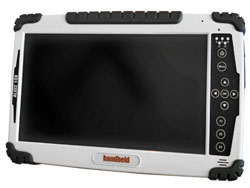 The Algiz 10X likewise is a Q-ship (i.e. an innocuous looking object that packs an unexpected punch). On the surface, it's just a rugged legacy tablet, albeit a remarkably compact and lightweight version. And while that is mostly what it is, the 10X hits a sweet spot between old-style rugged tablet and new-style media tablet. One that will likely resonate with quite a few buyers who still need full Windows 7 and full ruggedness on a tablet and also some legacy ports, all the while also wanting a bright wide-format hi-res screen and a nice contemporary look.
The Algiz 10X likewise is a Q-ship (i.e. an innocuous looking object that packs an unexpected punch). On the surface, it's just a rugged legacy tablet, albeit a remarkably compact and lightweight version. And while that is mostly what it is, the 10X hits a sweet spot between old-style rugged tablet and new-style media tablet. One that will likely resonate with quite a few buyers who still need full Windows 7 and full ruggedness on a tablet and also some legacy ports, all the while also wanting a bright wide-format hi-res screen and a nice contemporary look.
Then there's the Nautiz X1 rugged smartphone, and that's a real mindblower. By now there are quite a few attempts at providing consumer smartphone functionality in a tougher package, but none as small, sleek and elegant as the Nautiz X1. 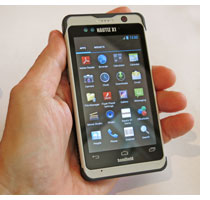 It measures 4.9 x 2.6 inches, which is exactly the size of the Samsung Galaxy S2 (the one before Samsung decided to make the displays almost as big as a tablet). At 0.6 inches it's thicker, and it weighs 6.3 ounces, but for that you get IP67 sealing (yes, totally waterproof), a ridiculously wide -4 to 140 degree operating temperature range, and all the MIL-STD-810G ruggedness specs you'd usually only get from something big and bulky. Which the Nautiz X1 definitely is not.
It measures 4.9 x 2.6 inches, which is exactly the size of the Samsung Galaxy S2 (the one before Samsung decided to make the displays almost as big as a tablet). At 0.6 inches it's thicker, and it weighs 6.3 ounces, but for that you get IP67 sealing (yes, totally waterproof), a ridiculously wide -4 to 140 degree operating temperature range, and all the MIL-STD-810G ruggedness specs you'd usually only get from something big and bulky. Which the Nautiz X1 definitely is not.
In fact, with its gorgeous 4-inch 800 x 480 pixel procap screen, Android 4.x, and fully contemporary smartphone guts, this is the tough smartphone Lowe's should have looked at before they bought all those tens of thousands of iPhones (see here). Don't get me wrong—I adore the iPhone, but it's devices like the Handheld Nautiz X1 that belong in the hands of folks who use smartphones on the job all day long, and on jobs where they get dropped and rained on and so on.
I don't know if Handheld is large enough to take full advantage of the remarkable products they have. They've done it before with that big contract in the Netherlands. But whatever may happen, it's hard not to be impressed with their fresh and competent products that go along with their great people, and their fresh and competently executed business plan.
Posted by conradb212 at 3:59 PM
















